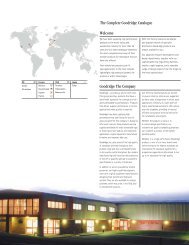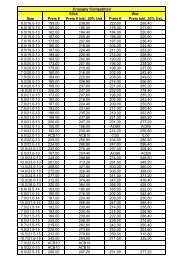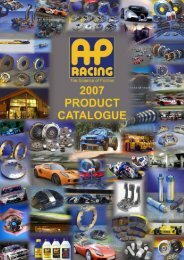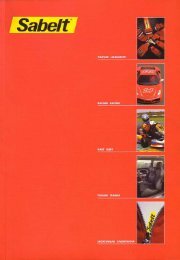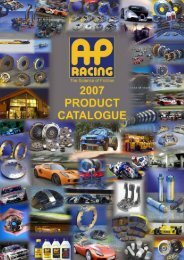You also want an ePaper? Increase the reach of your titles
YUMPU automatically turns print PDFs into web optimized ePapers that Google loves.
50<br />
Brake Discs<br />
face inside diameter to its outside diameter.<br />
This is very effective, however when<br />
the disc face heats up the groove acts a<br />
like a cold spot. This creates a thermal<br />
distortion on the braking face, which<br />
reduces braking effi ciency. The ‘J hook’<br />
design provides for a constant path of<br />
evenly distorted material on the braking<br />
face, the pad never loses contact with<br />
the braking face, improving the friction<br />
characteristics and brake performance.<br />
- Wide Disc<br />
Technology.<br />
In order<br />
for a disc<br />
to perform<br />
consistently<br />
the disc<br />
must effi ciently transfer heat to the<br />
surrounding atmosphere. This is particularly<br />
true in a racing situation where the<br />
braking events are extreme and frequent.<br />
Numerical simulation using both CFD<br />
and FEA techniques backed up by<br />
extensive dynamometer testing has<br />
allowed AP Racing to arrive at a new<br />
level of understanding of brake thermal<br />
performance and redefi ne disc design<br />
parameters to optimise cooling. We call<br />
this “Wide Disc Technology”.<br />
Wide Disc Technology is in fact a design<br />
tool that allows AP Racing to optimise<br />
disc performance. By redistributing the<br />
material in the disc, the cooling performance<br />
can be signifi cantly improved<br />
without increasing weight or stress.<br />
Dynamometer and vehicle testing have<br />
demonstrated actual temperature<br />
reductions of up to 150°C on some<br />
applications. The Wide Disc Technology<br />
can be applied to any disc brake<br />
application and will show worthwhile<br />
temperature reductions even where the<br />
overall width of the brake package is<br />
limited.<br />
- Strap Drive<br />
Disc<br />
Technology.<br />
This Strap<br />
Drive System<br />
has been<br />
developed by<br />
AP Racing<br />
both for Road and Race applications.<br />
The standard fi tment discs on many<br />
performance cars can suffer from brake<br />
vibrations caused by disc distortion. This<br />
generally occurs on fast road and track<br />
installations.<br />
On many performance cars the typical<br />
standard disc will be a heavy duty<br />
ventilated single piece casting. Couple<br />
this type of rigid disc to a standard hub<br />
and wheel bearing and the result is any<br />
hub distortion / run out will transfer onto<br />
the disc brake faces. This eventually<br />
results in brake vibrations, usually picked<br />
up through the steering wheel.<br />
The strap drive system offers a new take<br />
on the fl oating systems already in the<br />
market place. Strap drive uses a series<br />
of stainless steel straps to locate the disc<br />
to the mounting bell, producing a fl exible<br />
coupling between the hub and the disc<br />
faces. This allows the disc to run true in<br />
the caliper under all conditions and also<br />
permits the disc to expand and contract<br />
without being restricted.<br />
Some current replacement discs in the<br />
market place have evolved from<br />
Motorsport applications, they typically<br />
use a drive bobbin to provide some disc<br />
fl oat and were devised to reduce pad<br />
knock off on race cars. This system can<br />
work on a road application but there are<br />
some major drawbacks that the Strap<br />
Drive has overcome with its simplicity.<br />
Bobbin fl oat discs rely on a series of<br />
drive bobbins moving freely in drive<br />
slots. This movement can create wear<br />
during service and promote noise. The<br />
slots can fi ll up with road / brake debris<br />
causing them to seize. AP Racings strap<br />
couplings can’t suffer from any of these<br />
drawbacks. Therefore Service life, brake<br />
noise and also brake pedal travel are all<br />
improved.<br />
AP Racing has also introduced the strap<br />
drive system into a number of our current<br />
brake kit range.<br />
The key points with strap drive discs.<br />
- Compared with single piece discs the<br />
disc is de-coupled from hub, this allows<br />
disc to align itself perfectly within the<br />
caliper.<br />
- Improved pedal feel and brake response<br />
as a result of improved disc alignment<br />
within caliper.<br />
- Improved pedal feel at elevated<br />
temperatures as disc rotor is able to<br />
expand in a controlled manner with little<br />
infl uence from the disc mounting. This<br />
greatly reduces disc coning.<br />
- Controlled axial fl oat of disc rotor reduces<br />
brake ‘knock-off’ which can result in an<br />
inconsistent pedal feel.<br />
- No free moving parts means that the<br />
wear problems normally associated with<br />
fl oating disc designs is not present.<br />
- No free moving parts means that there<br />
are no clearances to become clogged<br />
with debris and corrosion which would<br />
prevent a conventional fl oating disc from<br />
operating correctly.<br />
- No free moving parts means no<br />
unwanted mechanical noise from discs.<br />
- Disc rotor and strap sub assembly<br />
available as service item for cost effective<br />
servicing.<br />
- Successfully used in race applications.<br />
Important note: When replacing brake<br />
pads with strap drive discs fi tted, do not<br />
push the pistons back in to the caliper<br />
by use of a lever against the discs. If<br />
this is done then the disc straps may be<br />
distorted and this can cause disc runout,<br />
resulting in possible brake vibration<br />
General Information<br />
DISC CHOICE<br />
The choice of a particular size and type<br />
of disc will depend on the characteristics<br />
of the vehicle. Experience with the type<br />
of installation or Racing format is very<br />
important.<br />
AP Racing has a wealth of experience<br />
of all types of Racing and our Technical<br />
Section will be pleased to advise on disc<br />
choice. Some of the main considerations in<br />
this choice are:<br />
HOMOLOGATION AND<br />
REGULATION<br />
In Group A and certain other classes of<br />
Racing, Brake equipment is restricted<br />
to that Homologated by the manufacturer<br />
with the FIA. Where applicable you must<br />
therefore choose a disc size / type which<br />
has been Homologated. E.g. only 4<br />
grooves are allowed in Formula 3.<br />
DISC DIAMETER AND<br />
THICKNESS<br />
Disc diameter and thickness are major<br />
factors in basic stopping power. Usually<br />
the largest diameter disc that can be<br />
installed in a particular wheel profi le is<br />
chosen to maximise braking power unless<br />
low weight, poor tyre adhesion or required<br />
brake balance dictate otherwise.<br />
Disc thicknesses normally increase with<br />
disc diameter and in proportion to vehicle<br />
weight and hence work done and cooling<br />
required. Standard disc sizes should be<br />
used wherever possible as this improves<br />
availability.<br />
NOTES<br />
www.apracing.com +44 (0)24 7663 9595



